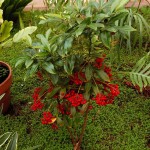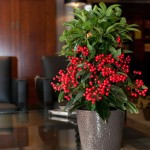Family: Myrsinaceae
Synonymous: Ardisia crenata var. bicolor
Ardisia crenata subsp. crassinervosa
Distribution and habitat: Ardisia crenata is a species of flowering plant in the colicwood family, Myrsinaceae, that is native to East Asia.
Ardisia crenata is a compact shrub that reaches 1 metre (3.3 feet), often with a single stem. Leaves are dark green, thick, glossy and have tightly waved edges The flowers are small, white or reddish, fragrant and form clusters. The fruit is a glossy, bright red drupe. The seeds are able to germinate under a dense canopy and are dispersed by birds and humans. Usually this shrubs are seen in fairly large colonies, since the plants re-seed freely.
Ardisia crenata is an invasive species in the southeastern United States, escaping captivity in wooded areas of Florida. Also, it is viewed as an environmental weed in Australia, particularly in its rainforests. Mature plants are prolific seed producers and can be surrounded by many seedlings, also leading to reduced seed germination of valued native species.
Description: Ardisia crenata is a popular indoor plant most appreciated for its long-lasting bright red berries that are produced in large numbers at the bottom half of the plant. When grown in a pot, it reaches a maximum height of only about 90cm (35 inch), with a spread of about 30-38cm (12-15 inch). It has glossy, dark green leathery leaves up to 15cm (6 inch) long. Thick clusters of star-shaped white or rose-pink flowers are produced usually in early summer. These are followed by very decorative shiny berries which are held on nearly horizontal stalks. The berries are gradually take on a bright red colour and normally persist on the plant until flowering time the following year.
Houseplant care: Red berries, glossy foliage and low maintenance distinguish this beautiful little shrub. Prune it back to keep this shrub compact. Pruning each spring before flowering will keep it in shape. This shrub will grow to a slow rate.
Light: Provide Ardisia crenata with bright light at all times with several hours every day of direct sunlight.
In summer, Ardisia crenata can be moved outdoors on a part shade spot.
Temperature: Ardisia crenata plants prefer to be grown cool, ideally at a maximum temperature of 15C (59F). In higher temperatures, high humidity is essential in order to prevent the berries from falling prematurely. It is a good idea to stand the plants on trays or saucers of moist pabbles and also mist-spray them daily to increase humidity.
Watering: While plants are in active growth, water them plentifully as often as necessary to keep the potting mixture thoroughly moist. During the rest period allow the top centimetre or so of the potting mixture to dry out between waterings if the plants are kept at normal room temperature; if the temperature can be held below 15C (59F), however, water even more sparingly, allowing at least half the potting mixture to dry out between waterings.
Feeding: Apply toArdisia crenata plants liquid fertiliser about every two weeks while plants are in active growth.
Potting and repotting: For the best result with Ardisia crenata use a soil based potting mixture. Move young plants into pots one size larger each spring until they reach the 13cm (5 inch) size where they will probably flower and fruit. Older plants tend to deteriorate and should be replaced when they have obviously begun to lose their vigour.
Gardening: Ardisia crenata is evergreen shrub unless killed back by very hard freezes without spring recovery. Where freezes are severe, these shrubs should be placed in a protected area or covered.
Prune lightly early spring to maintain its height and shape. Pinch back to promote a bushy habit.
Location: Ardisia crenata tolerates some direct sun, but not much without showing signs of distress. It grows best under a canopy of trees in fairly deep shade and protected from cold and drying winds.
Soil: Ardisia crenata likes deep soil rich with lots of organic matter, but it can also thrive in almost any non-soggy soil.
Irigation: These shrubs thrive in moist to average moist soil, but established Ardisia crenata is able to survive drought.
Fertilising: Mulch around plants or allow leaves and other debris from overhead trees to fall down naturally around them.
Propagation: Ardisia crenata plants are normally raised from seed sown in spring. Although this is possible in home, it is easier to buy young plants, which are usually sold in 8cm (3 inch) pots.
An alternative method of propagation is to take heel cuttings from lateral shoots during late spring or early summer. Sideshoot cuttings come away easily from the main stem with a small heel attached. Pot them in an equal-parts mixture of peat moss and sand and water them sparingly - just enough to keep the mixture moist. They should root in 6-8 weeks, especially if some form of bottom heat is provided from an electrical heated propagator. If this is not feasible, enclose the potted cuttings in a plastic bag and keep the bag in a place where it gets medium light and adequate warmth - not bellow 21C (70F) - until the roots have developed.
Ardisia crenata can also be propagated by air layering, a more difficult procedure.
Problems:
Ardisia crenata refuses to bloom.
Treatment: Give to Ardisia crenata plant more humidity and sunlight in spring, before starting to form buds. Regular misting with tepid water will help increase the moisture in the air around it.
Dropping flower buds are caused by drafty or cold air.
Treatment: Ardisia crenata likes it cool, but not too cold. It will tolerate a minimum winter temperature of 7C (45F).
Ardisia crenata plants are prone to mealybugs infestation.
Treatment: A regular, careful inspection is needed. Occasional watering with systemic insecticides based on Imidacloprid will keep the plants free of mealy bugs.
Note: Ardisia crenata is sometimes wrongly called Ardisia crispa, which is the name of a very similar plant.
Uses and display: Plant Ardisia crenata under trees and allow to colonize freely, thinning as necessary. Group in shrub borders, shade gardens or woodland areas. For best effect, plant a group of at least three. In frost-free areas, Ardisia crenata can become quite large and a single specimen might occupy the same space allowed for two or three elsewhere.
Ardisia crenata is easily transformed into a houseplant and is attractive for the shiny foliage and its persistent berries. It is a fine looking species which should be displayed in a prominent position. Also, it is great looking in a conservatory or hall way and grow well in greenhouses.
SUMMARY:
CHARACTERISTICS:
Foliage green
Features flowers and berries
Shape upright
Height: 90-100cm (36-40 inch)
PROPER CARE:
Watering in rest period sparingly
Watering in active growth period plentifully
Light bright
Temperature in rest period min 7C max 16C (45-61F)
Temperature in active growth period min 7C max 21C (45-70F)
Humidity high
Hardiness zone: 8a-9b





